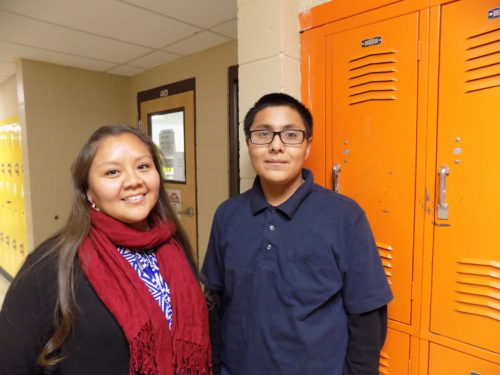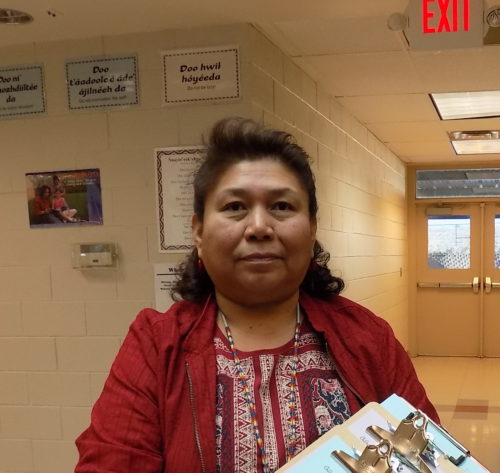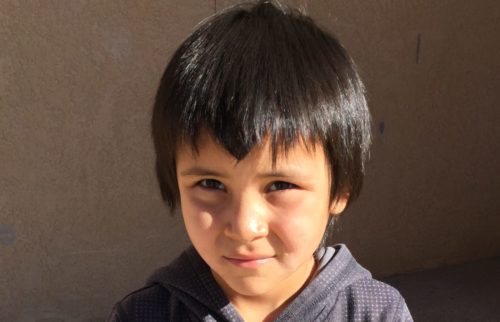The Na’ Neelzhiin Ji Olta’ Community School is located outside of the vast Navajo Nation in New Mexico, in a remote area of the state. The nearest post office, in Cuba, New Mexico, is thirty miles away. As a result, the school, which serves children from kindergarten through the eighth grade, is incredibly important for the families that live in the nearby communities – families who otherwise might not have a way to get their children to and from a school even farther away. Having actually been constructed by the people of the community with materials supplied by the Bureau of Indian Affairs, the school stands as a testimony to the determination of these Navajo families to see their children receive a good education.
Transferring schools is not ideal

Our Volunteer Coorindator Twilia with one of our sponsored children
Many of the residents in this region of New Mexico, where the unemployment rate is high, are living in poverty. Nearly all of the children enrolled at Na’ Neelzhiin Ji Olta’ Community School come from families too poor to afford even the most basic essentials, such as food and clothing, for their young ones. On a trip to visit the school, U.S. Programs Director, Renée Kube, met with our Volunteer Coordinator Twilia. Twilia’s background is in business management, and she is naturally meticulous in her work with the Children Incorporated program. When Renée me her, Twilia was warm and welcoming, and eager to discuss the community.
Twilia explained to Renée that there are often transfers of students between the Na’ Neelzhiin Ji Olta’ Community School and Pueblo Pintado Boarding School during the school year. Both schools are in the vicinity of Cuba, but they’re many miles away from it. The reason for the transfers is that Pueblo Pintado, which is also one of our affiliated projects in New Mexico, has a dormitory where the students can stay during the week; but the Na’ Neelzhiin Ji Olta’ Community School does not. When the annual potato harvest season comes around, parents withdrawal their kids from the Na’ Neelzhiin Ji Olta’ Community School, and enroll them at Pueblo Pintado Boarding School, so that they can go work in fields away from home, and at the same time, know that their kids are taken care of. Their kids stay at the dorms during the week, and go home on the weekends, when the parents have a break from farming.
When working with children who come from impoverished households, and who may also have the added challenge of changing schools every year, it is difficult to ensure that they are getting everything they need to succeed academically.
The only option
Transferring schools is not ideal, but it is the only option for many kids in poor families. In Cuba, employment opportunities are very limited. The next closest town is Bernalillo; and the closest city is Rio Rancho, but it’s quite a distance away – and many students’ parents have unreliable or no transportation. Many don’t have high school diplomas, either, so they can’t compete for better jobs.
Twilia told Renée that she has four volunteers who help her with shopping for our sponsored kids. All of the volunteers are teachers’ aides at the school. Twilia also says she has a great relationship with the school social worker. The social worker there is very proactive, and she is deeply concerned about the children’s welfare. She coordinates clothing drives and works with kids who come to school in need of hygiene items – and she even lets them use the showers there before classes start. She works in conjunction with Twilia to seek food donations, which is a great help.
It is wonderful that Twilia has so much support from other school staff members to help take care of the kids, both those that are enrolled in our program and those who are not. When working with children who come from impoverished households, and who may also have the added challenge of changing schools every year, it is difficult to ensure that they are getting everything they need to succeed academically.
***
HOW DO I SPONSOR A CHILD IN NEW MEXICO?
You can sponsor a child in New Mexico in one of two ways: call our office at 1-800-538-5381 and speak with one of our staff members, or email us at sponsorship@children-inc.org.



